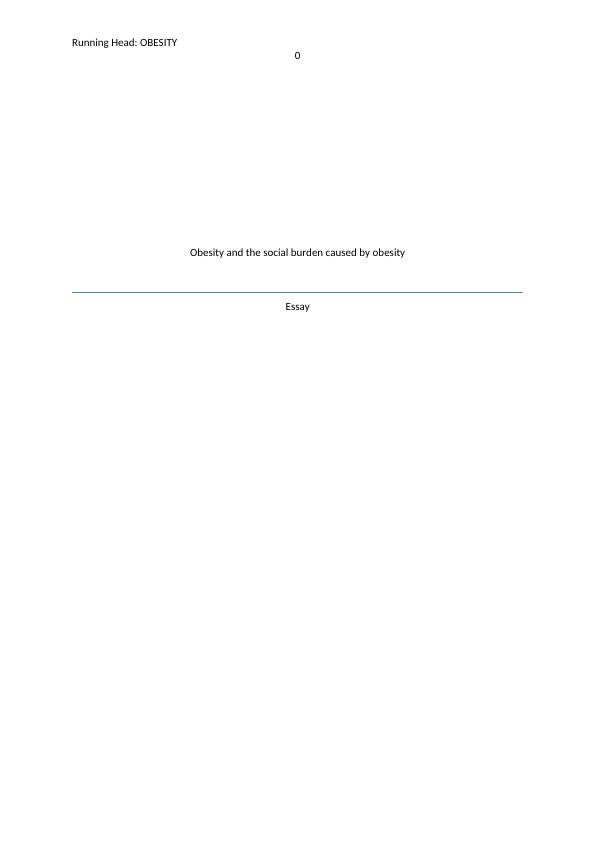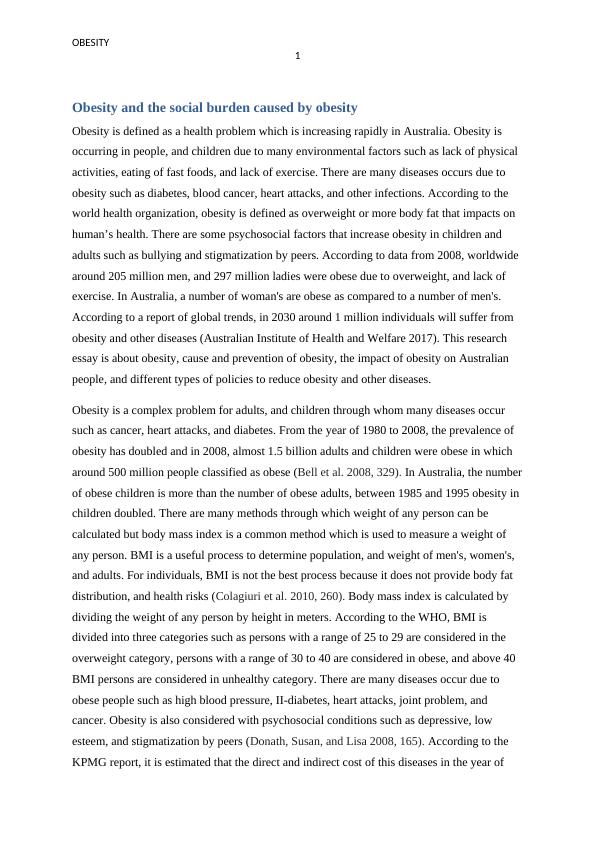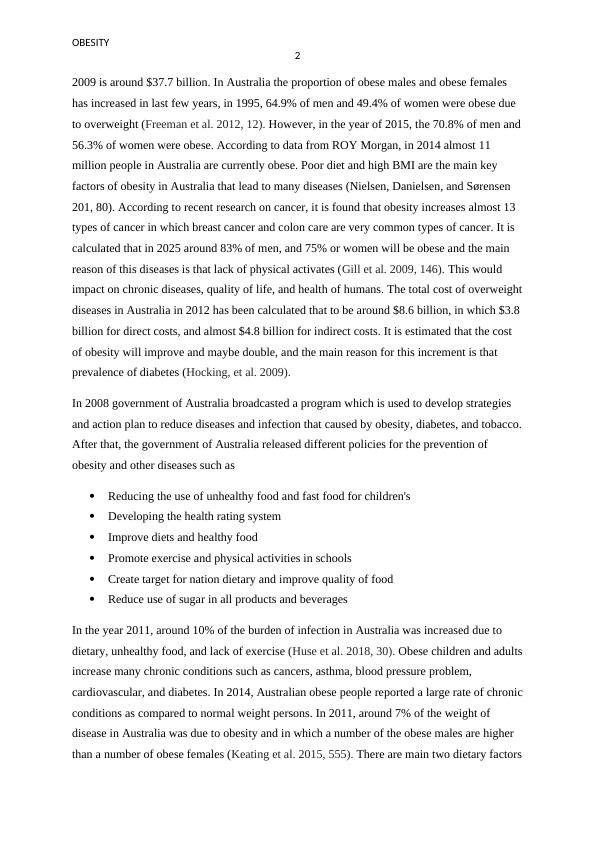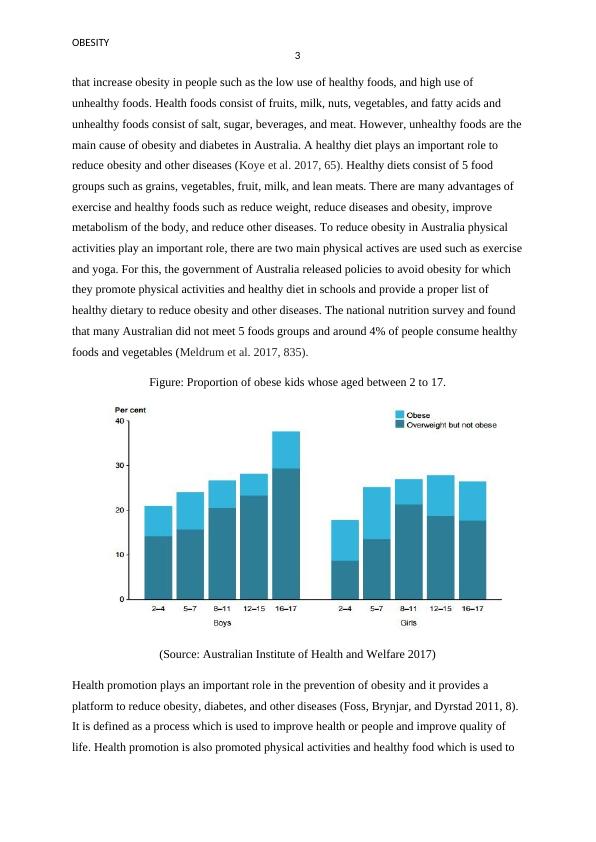Obesity and the Social Burden Caused by Obesity
Added on 2023-06-10
11 Pages4400 Words68 Views
Running Head: OBESITY
0
Obesity and the social burden caused by obesity
Essay
0
Obesity and the social burden caused by obesity
Essay

OBESITY
1
Obesity and the social burden caused by obesity
Obesity is defined as a health problem which is increasing rapidly in Australia. Obesity is
occurring in people, and children due to many environmental factors such as lack of physical
activities, eating of fast foods, and lack of exercise. There are many diseases occurs due to
obesity such as diabetes, blood cancer, heart attacks, and other infections. According to the
world health organization, obesity is defined as overweight or more body fat that impacts on
human’s health. There are some psychosocial factors that increase obesity in children and
adults such as bullying and stigmatization by peers. According to data from 2008, worldwide
around 205 million men, and 297 million ladies were obese due to overweight, and lack of
exercise. In Australia, a number of woman's are obese as compared to a number of men's.
According to a report of global trends, in 2030 around 1 million individuals will suffer from
obesity and other diseases (Australian Institute of Health and Welfare 2017). This research
essay is about obesity, cause and prevention of obesity, the impact of obesity on Australian
people, and different types of policies to reduce obesity and other diseases.
Obesity is a complex problem for adults, and children through whom many diseases occur
such as cancer, heart attacks, and diabetes. From the year of 1980 to 2008, the prevalence of
obesity has doubled and in 2008, almost 1.5 billion adults and children were obese in which
around 500 million people classified as obese (Bell et al. 2008, 329). In Australia, the number
of obese children is more than the number of obese adults, between 1985 and 1995 obesity in
children doubled. There are many methods through which weight of any person can be
calculated but body mass index is a common method which is used to measure a weight of
any person. BMI is a useful process to determine population, and weight of men's, women's,
and adults. For individuals, BMI is not the best process because it does not provide body fat
distribution, and health risks (Colagiuri et al. 2010, 260). Body mass index is calculated by
dividing the weight of any person by height in meters. According to the WHO, BMI is
divided into three categories such as persons with a range of 25 to 29 are considered in the
overweight category, persons with a range of 30 to 40 are considered in obese, and above 40
BMI persons are considered in unhealthy category. There are many diseases occur due to
obese people such as high blood pressure, II-diabetes, heart attacks, joint problem, and
cancer. Obesity is also considered with psychosocial conditions such as depressive, low
esteem, and stigmatization by peers (Donath, Susan, and Lisa 2008, 165). According to the
KPMG report, it is estimated that the direct and indirect cost of this diseases in the year of
1
Obesity and the social burden caused by obesity
Obesity is defined as a health problem which is increasing rapidly in Australia. Obesity is
occurring in people, and children due to many environmental factors such as lack of physical
activities, eating of fast foods, and lack of exercise. There are many diseases occurs due to
obesity such as diabetes, blood cancer, heart attacks, and other infections. According to the
world health organization, obesity is defined as overweight or more body fat that impacts on
human’s health. There are some psychosocial factors that increase obesity in children and
adults such as bullying and stigmatization by peers. According to data from 2008, worldwide
around 205 million men, and 297 million ladies were obese due to overweight, and lack of
exercise. In Australia, a number of woman's are obese as compared to a number of men's.
According to a report of global trends, in 2030 around 1 million individuals will suffer from
obesity and other diseases (Australian Institute of Health and Welfare 2017). This research
essay is about obesity, cause and prevention of obesity, the impact of obesity on Australian
people, and different types of policies to reduce obesity and other diseases.
Obesity is a complex problem for adults, and children through whom many diseases occur
such as cancer, heart attacks, and diabetes. From the year of 1980 to 2008, the prevalence of
obesity has doubled and in 2008, almost 1.5 billion adults and children were obese in which
around 500 million people classified as obese (Bell et al. 2008, 329). In Australia, the number
of obese children is more than the number of obese adults, between 1985 and 1995 obesity in
children doubled. There are many methods through which weight of any person can be
calculated but body mass index is a common method which is used to measure a weight of
any person. BMI is a useful process to determine population, and weight of men's, women's,
and adults. For individuals, BMI is not the best process because it does not provide body fat
distribution, and health risks (Colagiuri et al. 2010, 260). Body mass index is calculated by
dividing the weight of any person by height in meters. According to the WHO, BMI is
divided into three categories such as persons with a range of 25 to 29 are considered in the
overweight category, persons with a range of 30 to 40 are considered in obese, and above 40
BMI persons are considered in unhealthy category. There are many diseases occur due to
obese people such as high blood pressure, II-diabetes, heart attacks, joint problem, and
cancer. Obesity is also considered with psychosocial conditions such as depressive, low
esteem, and stigmatization by peers (Donath, Susan, and Lisa 2008, 165). According to the
KPMG report, it is estimated that the direct and indirect cost of this diseases in the year of

OBESITY
2
2009 is around $37.7 billion. In Australia the proportion of obese males and obese females
has increased in last few years, in 1995, 64.9% of men and 49.4% of women were obese due
to overweight (Freeman et al. 2012, 12). However, in the year of 2015, the 70.8% of men and
56.3% of women were obese. According to data from ROY Morgan, in 2014 almost 11
million people in Australia are currently obese. Poor diet and high BMI are the main key
factors of obesity in Australia that lead to many diseases (Nielsen, Danielsen, and Sørensen
201, 80). According to recent research on cancer, it is found that obesity increases almost 13
types of cancer in which breast cancer and colon care are very common types of cancer. It is
calculated that in 2025 around 83% of men, and 75% or women will be obese and the main
reason of this diseases is that lack of physical activates (Gill et al. 2009, 146). This would
impact on chronic diseases, quality of life, and health of humans. The total cost of overweight
diseases in Australia in 2012 has been calculated that to be around $8.6 billion, in which $3.8
billion for direct costs, and almost $4.8 billion for indirect costs. It is estimated that the cost
of obesity will improve and maybe double, and the main reason for this increment is that
prevalence of diabetes (Hocking, et al. 2009).
In 2008 government of Australia broadcasted a program which is used to develop strategies
and action plan to reduce diseases and infection that caused by obesity, diabetes, and tobacco.
After that, the government of Australia released different policies for the prevention of
obesity and other diseases such as
Reducing the use of unhealthy food and fast food for children's
Developing the health rating system
Improve diets and healthy food
Promote exercise and physical activities in schools
Create target for nation dietary and improve quality of food
Reduce use of sugar in all products and beverages
In the year 2011, around 10% of the burden of infection in Australia was increased due to
dietary, unhealthy food, and lack of exercise (Huse et al. 2018, 30). Obese children and adults
increase many chronic conditions such as cancers, asthma, blood pressure problem,
cardiovascular, and diabetes. In 2014, Australian obese people reported a large rate of chronic
conditions as compared to normal weight persons. In 2011, around 7% of the weight of
disease in Australia was due to obesity and in which a number of the obese males are higher
than a number of obese females (Keating et al. 2015, 555). There are main two dietary factors
2
2009 is around $37.7 billion. In Australia the proportion of obese males and obese females
has increased in last few years, in 1995, 64.9% of men and 49.4% of women were obese due
to overweight (Freeman et al. 2012, 12). However, in the year of 2015, the 70.8% of men and
56.3% of women were obese. According to data from ROY Morgan, in 2014 almost 11
million people in Australia are currently obese. Poor diet and high BMI are the main key
factors of obesity in Australia that lead to many diseases (Nielsen, Danielsen, and Sørensen
201, 80). According to recent research on cancer, it is found that obesity increases almost 13
types of cancer in which breast cancer and colon care are very common types of cancer. It is
calculated that in 2025 around 83% of men, and 75% or women will be obese and the main
reason of this diseases is that lack of physical activates (Gill et al. 2009, 146). This would
impact on chronic diseases, quality of life, and health of humans. The total cost of overweight
diseases in Australia in 2012 has been calculated that to be around $8.6 billion, in which $3.8
billion for direct costs, and almost $4.8 billion for indirect costs. It is estimated that the cost
of obesity will improve and maybe double, and the main reason for this increment is that
prevalence of diabetes (Hocking, et al. 2009).
In 2008 government of Australia broadcasted a program which is used to develop strategies
and action plan to reduce diseases and infection that caused by obesity, diabetes, and tobacco.
After that, the government of Australia released different policies for the prevention of
obesity and other diseases such as
Reducing the use of unhealthy food and fast food for children's
Developing the health rating system
Improve diets and healthy food
Promote exercise and physical activities in schools
Create target for nation dietary and improve quality of food
Reduce use of sugar in all products and beverages
In the year 2011, around 10% of the burden of infection in Australia was increased due to
dietary, unhealthy food, and lack of exercise (Huse et al. 2018, 30). Obese children and adults
increase many chronic conditions such as cancers, asthma, blood pressure problem,
cardiovascular, and diabetes. In 2014, Australian obese people reported a large rate of chronic
conditions as compared to normal weight persons. In 2011, around 7% of the weight of
disease in Australia was due to obesity and in which a number of the obese males are higher
than a number of obese females (Keating et al. 2015, 555). There are main two dietary factors

OBESITY
3
that increase obesity in people such as the low use of healthy foods, and high use of
unhealthy foods. Health foods consist of fruits, milk, nuts, vegetables, and fatty acids and
unhealthy foods consist of salt, sugar, beverages, and meat. However, unhealthy foods are the
main cause of obesity and diabetes in Australia. A healthy diet plays an important role to
reduce obesity and other diseases (Koye et al. 2017, 65). Healthy diets consist of 5 food
groups such as grains, vegetables, fruit, milk, and lean meats. There are many advantages of
exercise and healthy foods such as reduce weight, reduce diseases and obesity, improve
metabolism of the body, and reduce other diseases. To reduce obesity in Australia physical
activities play an important role, there are two main physical actives are used such as exercise
and yoga. For this, the government of Australia released policies to avoid obesity for which
they promote physical activities and healthy diet in schools and provide a proper list of
healthy dietary to reduce obesity and other diseases. The national nutrition survey and found
that many Australian did not meet 5 foods groups and around 4% of people consume healthy
foods and vegetables (Meldrum et al. 2017, 835).
Figure: Proportion of obese kids whose aged between 2 to 17.
(Source: Australian Institute of Health and Welfare 2017)
Health promotion plays an important role in the prevention of obesity and it provides a
platform to reduce obesity, diabetes, and other diseases (Foss, Brynjar, and Dyrstad 2011, 8).
It is defined as a process which is used to improve health or people and improve quality of
life. Health promotion is also promoted physical activities and healthy food which is used to
3
that increase obesity in people such as the low use of healthy foods, and high use of
unhealthy foods. Health foods consist of fruits, milk, nuts, vegetables, and fatty acids and
unhealthy foods consist of salt, sugar, beverages, and meat. However, unhealthy foods are the
main cause of obesity and diabetes in Australia. A healthy diet plays an important role to
reduce obesity and other diseases (Koye et al. 2017, 65). Healthy diets consist of 5 food
groups such as grains, vegetables, fruit, milk, and lean meats. There are many advantages of
exercise and healthy foods such as reduce weight, reduce diseases and obesity, improve
metabolism of the body, and reduce other diseases. To reduce obesity in Australia physical
activities play an important role, there are two main physical actives are used such as exercise
and yoga. For this, the government of Australia released policies to avoid obesity for which
they promote physical activities and healthy diet in schools and provide a proper list of
healthy dietary to reduce obesity and other diseases. The national nutrition survey and found
that many Australian did not meet 5 foods groups and around 4% of people consume healthy
foods and vegetables (Meldrum et al. 2017, 835).
Figure: Proportion of obese kids whose aged between 2 to 17.
(Source: Australian Institute of Health and Welfare 2017)
Health promotion plays an important role in the prevention of obesity and it provides a
platform to reduce obesity, diabetes, and other diseases (Foss, Brynjar, and Dyrstad 2011, 8).
It is defined as a process which is used to improve health or people and improve quality of
life. Health promotion is also promoted physical activities and healthy food which is used to

End of preview
Want to access all the pages? Upload your documents or become a member.
Related Documents
Reducing Teenage Obesity with Diverse Exercise & Dieting Educationlg...
|9
|2298
|426
Childhood Obesity Facts & Statisticslg...
|4
|2365
|478
The Impact of Obesity on Adult Well-beinglg...
|38
|7011
|204
Causes, Symptoms, and Interventions for Obesitylg...
|8
|2037
|39
Obesity and Overweight Assignment PDFlg...
|8
|2477
|65
Obesity: Determinants and Prevention Approacheslg...
|13
|3511
|469
